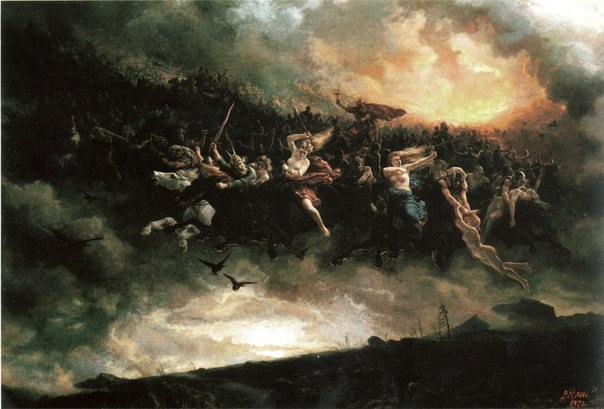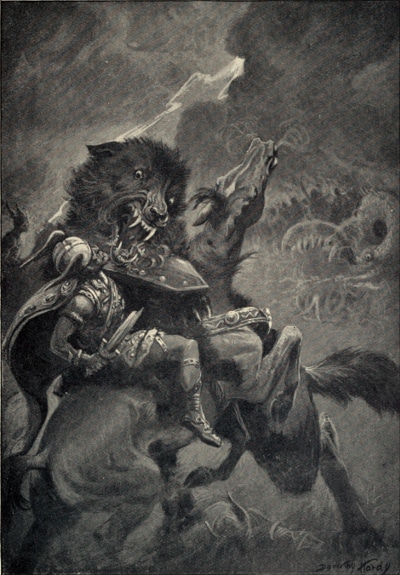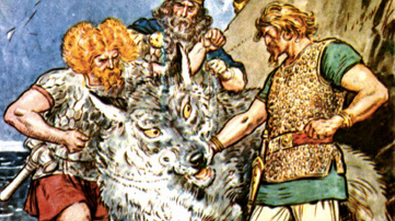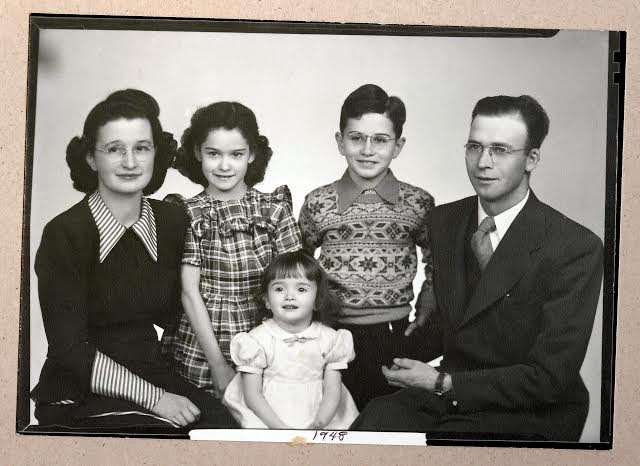
Throughout this series on Norse mythology, I’ve referenced Ragnarok — the Norse apocalypse. It’s where gods and beasts alike meet their demise, and the world crashes into oblivion.
Calling it an apocalypse was actually a little misleading, though. You see, Ragnarok wasn’t actually the end of all things, but rather the end of a certain era. It was both the destruction and subsequent recreation of the cosmos.
For the Vikings, time wasn’t seen as linear; it didn’t have a start and an end. It was cyclical; seasons came and went and came again, and life’s blessings and trials ebbed and flowed along with it.
In this final piece of our Norse mythology series, let’s explore what a man can learn from Ragnarok. First, though, we need to know the myth itself.

Throughout the era of the Norse gods, prophecies and oracles foretold of their doom — that they wouldn’t be around forever. With the death of Baldur — one of the signs of the coming Ragnarok — the gods knew their destiny was inescapable.
As Ragnarok approached, the humans in Midgard disregarded their way of life, giving up the bonds of brotherhood and engaging in endless wars. Murder and incest became common, and people sunk into a lifeless nihilism. Three straight years went by with no hint of summer — a season of darkness and coldness which the prophecies had deemed The Great Winter.
Then, Loki and his wolf-son Fenrir each broke free of their imprisonments and set about to destroy the gods in Asgard, and along with them, the entire world. They recruited a vast army of giants and sailed to the gates of the gods’ fortress in the ship Naglfar, which was made from the fingernails and toenails of dead men.
Fenrir enclosed the land and sky within his jaws and consumed everything in between. Jormungand — the world-encircling, sea-dwelling serpent — emerged from his home to spit poison upon the earth. Another beast, Surt, swept across the world with a flaming sword, leaving it a scorching, barren landscape.

Thor battling his archenemy, Jormungand
Amidst the chaos and destruction, the gods fought valiantly to turn back the apocalypse, and at the least, destroy the beast-enemies of mankind. Eternal foes Thor and Jormungand killed each other in battle, as did Tyr and the great hound named Garm. Heimdall, guardian of Asgard’s gate, fought Loki in another mutually destructive bout. Odin fell to Fenrir, but revenge was served when Fenrir was then killed by Odin’s son Vidar. The battlefield was awash in the blood of the gods and beasts alike.
After the fighting was complete, with the gods stricken dead and resigned to the underworld, the land fell back into the sea, and the black void known as Ginnungagap (which you’ll remember from the Norse creation story) once again appeared.
Remember, though, this wasn’t the ultimate end.
After a time, the earth returned to form. A new human pair named Lif and Lifthrasir appeared. Baldur returned from the dead, along with the sons of Odin and of Thor. A new sun emerged, even stronger than the last. Life and light once again reigned in the universe rather than darkness and destruction.
The gears of the world once more began to turn, filling creation with new energy and spirit, and moving the universe towards yet another Ragnarok, and another creation, ad infinitum.

What can men learn from this story of the Viking “apocalypse”?
Life has cycles.
The end wasn’t really the end for the Norse world. Destruction was wrought, but out of the ashes arose a new world. Whether this cosmic death and rebirth will truly occur is a matter of faith (it’s a belief of not only the Vikings but other religions as well). The cyclical nature of our earthly lives, however, isn’t in doubt. One can witness it in nature, of course — the sun comes up, the sun sets; seeds grow, bloom, and die. But cycles structure human activities as well. It’s true of cultural trends; things die out and come back into vogue again every day. It’s true of economics; what goes up — the stock market — must come down again, even if it generally spirals in an upwards direction. It’s even true of our world events; generations of men and of history go through periods of awakening and unraveling.
So with the knowledge that life is cyclical, what are men to do? How can this improve our lives?
On a macro level, knowing that everything moves in cycles reminds us not to overly despair when the world seems to be going to pot; while we may be in a trough right now, the cycle will come around again and bring a rebirth. The end is not the end.
On a more micro level, the cyclical nature of life teaches us that progress and success should not be measured on a linear plane; it rarely looks like a line moving straight up.
While we can surely spiral upwards, there will be dips in life — times where you feel stagnant, like nothing is working, that you’ve reached the end of your rope. These times shouldn’t be seen as failures, as we often view them, but as challenges and opportunities and even as times for recovery. In our hyper-productivity-focused world, any dip is frowned upon. Is it realistic, though, for productivity to continue to go up and up and up? Isn’t there a breaking point where it has to go down a bit (even if in the form of a vacation or intentional break) for the sake of one’s health and sanity?
Just as the Viking universe went through periods of void and creation, just as trees and plants blossom, die, and burst forth once more, so do our feelings and creativity ebb and flow. Sometimes your business is up and sometimes it’s down. Sometimes your mind is feeling fertile and your writing pours forth like a spigot, and sometimes you pass through periods where you feel barren of good ideas. Sometimes you feel euphorically happy, and sometimes you sink into inexplicable funks.
Cycles are at work not only in your job and your emotions, but in your relationships as well. In love, do your day-to-day feelings go up and up every single day? Or do your feelings ebb and flow a little bit, even while you’re able to look at the long term and see that your love for each other has steadily grown and strengthened? This is perhaps why couples break up or divorce; they no longer have the same feelings for each other they once did. The relationship is viewed on a linear plane, and if that line starts to dip, it’s time to call it quits.
While all kinds of temporary downturns are natural, and not a cause for panic, they also shouldn’t be an excuse for complacency. Rather, they serve as opportunities to analyze what you’ve been doing, how you might improve, and to try new things to get growing again. Got writer’s block? Maybe you need to institute a new routine or ritual. Business taking a dip? Examine how you can improve your customers’ experience. Marriage feeling rocky? Stop taking each other for granted and start dating each other again.
It seems to me that I’m most encouraged in life when looking at the long game. I don’t necessarily ask myself if I’ve improved from yesterday. It can be debilitating to think about constant improvement on such a small scale like that. A single bad day could ruin what might have been a good week or a good month.
Because I’m aware of these cycles, I prefer to self-reflect over longer chunks of time. Have I improved from last month? Last quarter? Last year? When looking at those larger scales, it’s certainly easy to see things spiraling up, even with wintery periods here and there.
Now, this isn’t to say that when good times are rollin’ you should live in fear of a karmic downturn. Rather, simply set your mind that it won’t always be smooth sailing, and do the only thing you can do: focus on becoming antifragile, so when the cycle starts to dip, you can be ready and emerge from the other side stronger than ever.
A man fights until the very end, even in the face of defeat.

Odin fights Fenrir
The Norse gods knew their destiny. They had heard the prophecies, and once the death of Baldur came to pass, it became clear there was no escaping fate. And yet the gods fought bravely in their battles of Ragnarok. Even in the awareness of their inevitable defeat, they did not just give up the ship. They gave it their all until they physically no longer could.
Just as in the previous point, there are lessons here on both the societal and personal level.
In the cycles of history, you may be sure a rebirth of some kind is coming, but the reality is that you may not live to see it. This can spur a nihilistic viewpoint — that if the world has to hit rock bottom before things turn around, you might as well not even try to make things better. You simply withdraw from supporting or adding anything to the culture — content to enjoy the decline.
But that definitely wasn’t the mindset of the Norse gods. They had a long view of the death of their world and their own demise. They knew for a good while what was coming. It wasn’t like they went into battle with an optimistic mindset — they were bound to be ultimately defeated from the get-go. And yet they still fought with all they had.
We shouldn’t go down without a fight either. Not in our individual lives or our society.
We should steadfastly strive to be creators rather than consumers. We should work to attain ideal manhood. We’ll never be perfect; we’ll never get to where we actually want to be as humans. We’ll strive and strive, but ultimately continue to have failings and shortcomings. We will be defeated by the reality of humanity itself.
Perfection, of course, is not possible. And our efforts may not be appreciated by those around us, or by the culture at large. But contrary to what our brain might say — that lazing about with a purely epicurean view will be the most satisfying — it’s actually in striving and fighting and taking on challenge that the most fulfillment is to be found in life. Why else do people talk about things like climbing mountains and raising children and building companies as some of life’s most rewarding experiences? They’re life’s toughest tasks, but offer the greatest rewards at the top.
As Benjamin Franklin said of his own pursuit of excellence, “Tho’ I never arrived at the perfection I had been so ambitious of obtaining, but fell far short of it, yet I was, by the endeavour, a better and a happier man than I otherwise should have been if I had not attempted it.”
Our ultimate defeat is also true in another sense in that we won’t beat worldly death. At some point, we will die, and be no more for the Earth. In the face of this defeat, should we just give up and say “What’s the point?” Of course not! Meditating on death can actually make us better men. Knowing that we won’t be here forever can and should spur you on to live and do greater deeds. Your time here is finite, so do what you can with the time you have to make a difference in the world — to love more fully, to act more boldly, to work with more hustle, to push your body and mind more intensely.
While the weak man will take these inevitable defeats and wallow in them like a pig in the mud, the man of action, who longs for self-progress and virility, will follow the Norse example and be all the more inspired to carpe each and every diem.
We must do all we can to raise the next generation well.
When I became a father about four weeks ago, it seemed my whole worldview was flipped on its head overnight. It’s become clear to me that one of my greatest tasks in life is to raise my son — and any future progeny — well.
The work a man does in his job may or may not live beyond his own lifetime, but god-willing his children sure will. If you teach them what it means to live well — to love, to work hard, to live with character and honor — perhaps the world will become a little bit better because of it once you’ve passed on.
When our generation of leaders and builders and innovators ceases to exist, what’s left? Only the generations who come after us, and what we’ve taught them. Had Odin and Thor not raised their sons well, the newly created world may not have gotten off to as good a start. Had the values of the gods not been passed down, would light still have reigned over darkness?
Every generation creates the world anew. Whether you’re a literal dad, or simply a fatherly mentor to others, do all you can to offer rising youth the tools for renewal and the power to bring forth a spectacular rebirth.
Read the Series:
______________
Sources and Further Reading
Gods and Myths of Northern Europe by H.R. Ellis Davidson. This textbook from 1965 is a surprisingly readable guide to not only Norse myths, but their context and symbolism within the Viking culture.
The Age of the Vikings by Anders Winroth. This is a history of the Viking people, rather than a specific look at Norse mythology. It helps set the stage, however, and does well in giving an honest account of their culture.
The Poetic Edda (Hollander translation). A collection of anonymous mythical poetry and verse from the 1300s that serves as an origin text for many Norse myths.
The Prose Edda by Snorri Sturluson. A textbook-like work from the Icelandic historian which compiles Norse myths. This, along with The Poetic Edda, offer the majority of source material for Norse mythology.
Nordic Gods and Heroes by Padraic Colum. This is a collection of reimagined and rewritten Norse myths. They’re in a language that captures the beauty and inspirational nature of the tales rather than a rote translation of ancient words.
Norse Mythology for Smart People. An online treasure trove of articles and information about the mythological Norse universe.







